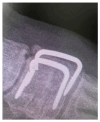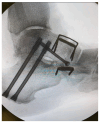Continuous Compression Implants in Foot and Ankle Surgery: Tips and Tricks
- PMID: 40429502
- PMCID: PMC12112034
- DOI: 10.3390/jcm14103507
Continuous Compression Implants in Foot and Ankle Surgery: Tips and Tricks
Abstract
Background: Continuous Compression Implants (CCIs) are low-profile implants made of nitinol and titanium. They offer multiple benefits in comparison to plate and screw fixation for foot and ankle indications, and they are designed in such a way that they continuously and dynamically compress the opposed bony surfaces throughout the entire healing process. Methods: In this study, we present our experience on the use of those nitinol implants for midfoot and hindfoot surgery. Furthermore, we elaborate on the advantages and downsides of using this internal fixation method and highlight common pitfalls which could lead to undesirable clinical outcomes. We also demonstrate our proposed surgical technique on how to use CCIs in a reproducible and reliable way and present surgical tips which could help reduce surgical time when utilising these implants. We also make surgical recommendations on their use and present the underlying biomechanics, which could provide a better understanding of the rationale behind using them in the field of foot and ankle surgery. Last but not least, we presented the early clinical and radiological results of a series of patients who underwent primary midfoot fusion for Lisfranc injury between 2020 and 2023. Results: With a minimum follow-up of 9 months, satisfactory clinical and radiological union was noted in all those patients. The mean difference between pre- and post-operative MOxFQ scores was -37.7 (95% CI was 16.9 to 58.5; p = 0.03). The mean post-operative VAS pain at rest was 3.2 (SD = 2.3). No major complications were noted. Conclusions: CCI internal fixation is a safe, reproducible, and reliable method when it comes to foot and ankle conditions, but it requires appropriate pre-operative planning, surgical training, and careful implantation.
Keywords: Lisfranc; continuous compression implants; midfoot/hindfoot fusion; staples; surgical technique.
Conflict of interest statement
The authors declare no conflict of interest.
Figures







References
-
- Aiyer A., Russell N.A., Pelletier M.H., Myerson M., Walsh W.R. The Impact of Nitinol Staples on the Compressive Forces, Contact Area, and Mechanical Properties in Comparison to a Claw Plate and Crossed Screws for the First Tarsometatarsal Arthrodesis. Foot Ankle Spec. 2016;9:232–240. doi: 10.1177/1938640015620655. - DOI - PubMed
-
- Sands A., Zderic I., Swords M., Gehweiler D., Ciric D., Roth C., Nötzli C., Gueorguiev B. First Tarsometatarsal Joint Fusion in Foot—A Biomechanical Human Anatomical Specimen Analysis with Use of Low-Profile Nitinol Staples Acting as Continuous Compression Implants. Medicina. 2023;59:1310. doi: 10.3390/medicina59071310. - DOI - PMC - PubMed
LinkOut - more resources
Full Text Sources

